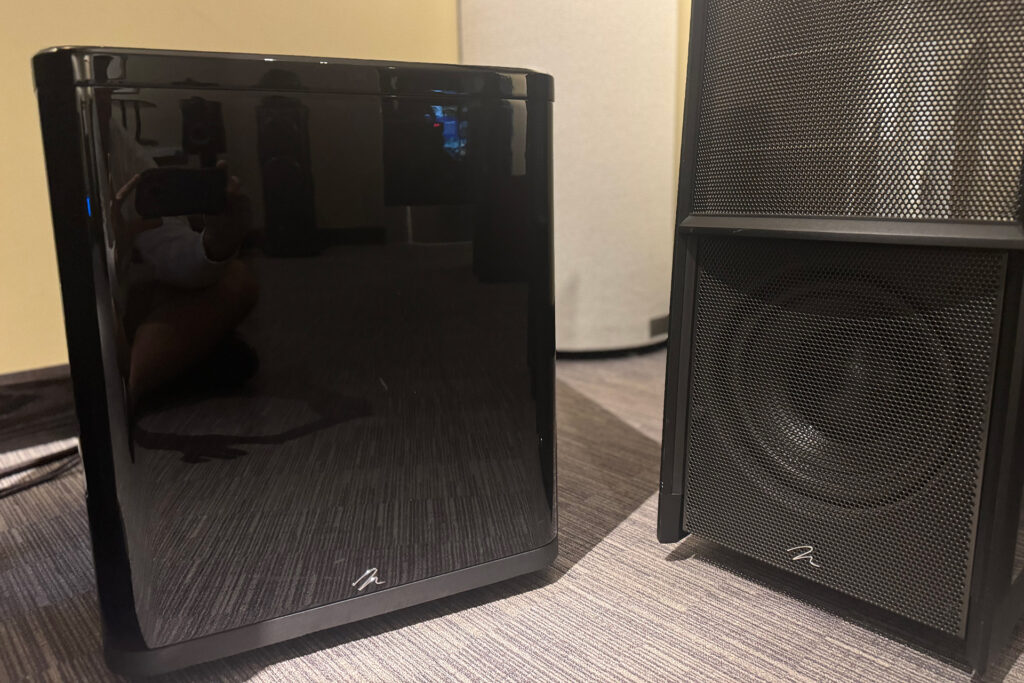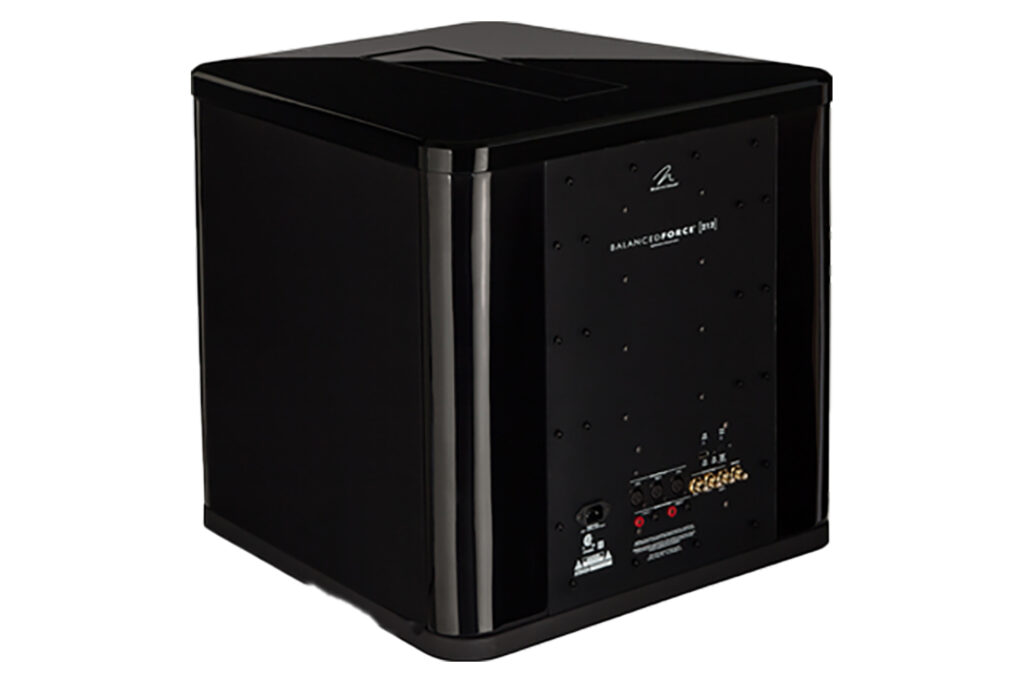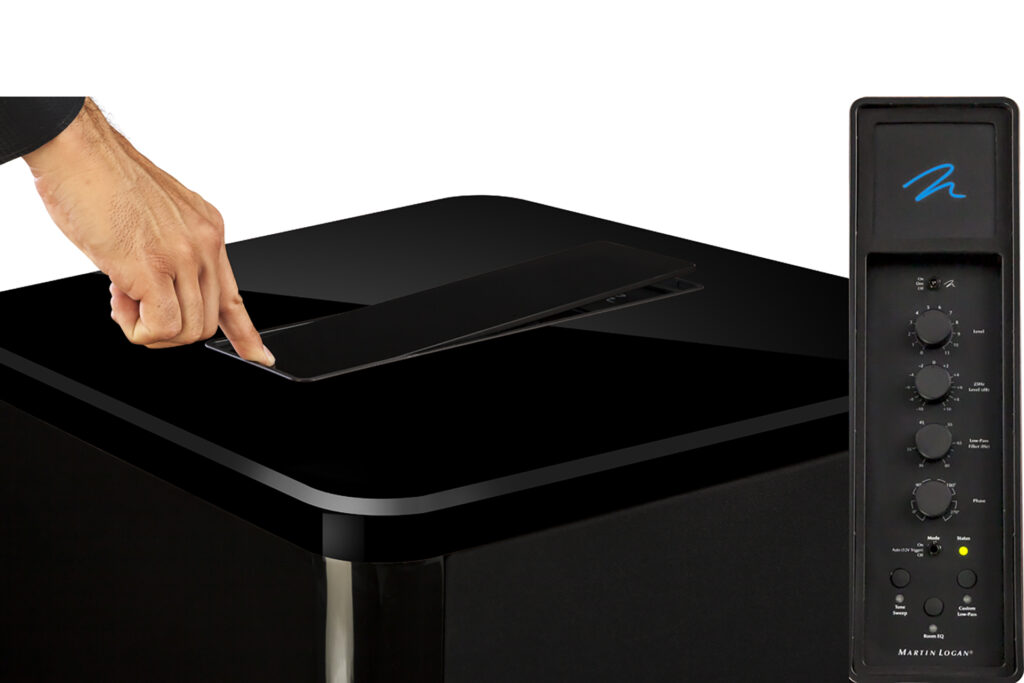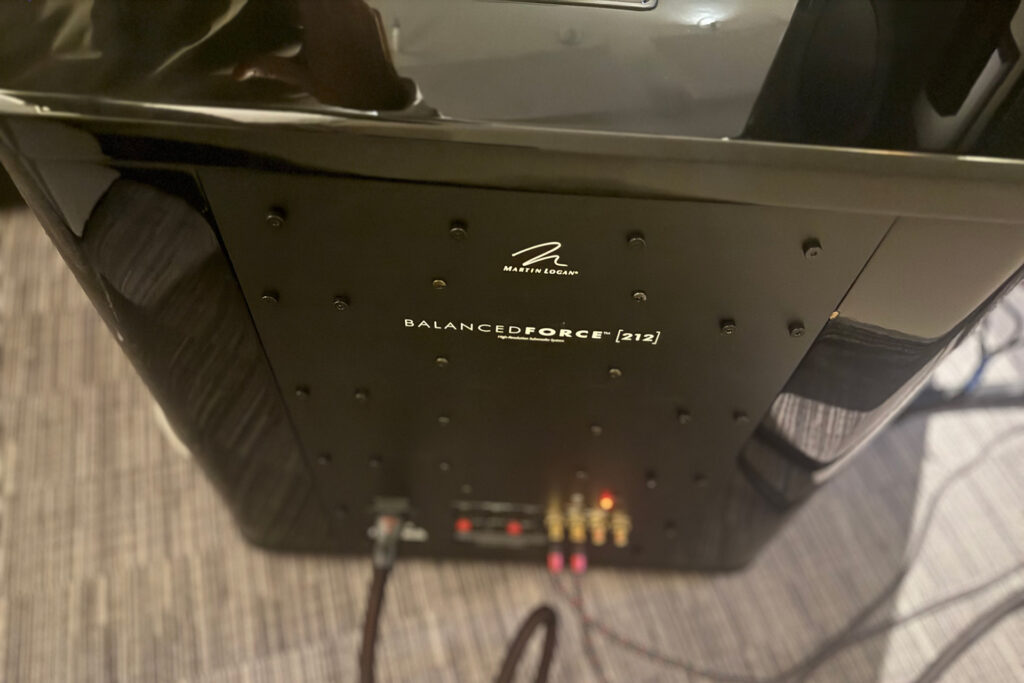MartinLogan gets more editorial and consumer attention for its hybrid electrostatic loudspeakers than it does for its subwoofers, which is a bit of a shame. The design resources that MartinLogan and its sibling brand, Paradigm, have available to them in Canada are meaningful, and the resulting subwoofer designs for both brands are pretty kickass, even if other loudspeaker brands get more love for their audiophile subwoofers.
The MartinLogan BalancedForce 212 is a $4,499 reference-grade, large format audiophile subwoofer. The subwoofer reportedly measures below the magic 20 Hz mark (18Hz to be specific), and has a massive reserve of internal power. There’s topnotch room correction included in the asking, which gets pretty sophisticated when it comes to getting the most out of not your sub, but also your overall system. Can the MartinLogan BalancedForce 212 perform with the absolute best subwoofers on the market today? That’s what we are going to see as this is a physically big subwoofer with even bigger expectations …

What Makes the MartinLogan BalancedForce 212 Subwoofer Special?
- The MartinLogan BalancedForce 212 is a large subwoofer, but doesn’t come across as obtrusive visually because of its slick industrial design. MartinLogan ESL speakers are industrial design icons in the audiophile world. The MartinLogan BalancedForce 212, even at 140 pounds, has the sleek lines to blend in.
- Speaking of blending in, the MartinLogan BalancedForce 212 subwoofer uses Anthem Room Correction and the Perfect Bass Kit for room correction. I use ARC (Anthem Room Correction) for my invisible speakers and in-ceiling subwoofers. I use ARC (when not reviewing other gear) when using my Anthem STR stereo preamp. Subwoofers likely benefit the most from this type of room correction. The Perfect Bass kit is how my subwoofer was set up, and that mic product comes at an additional cost. Getting your subwoofer to blend into your speakers is a far bigger benefit that getting a few Hertz lower performance on a test tone, in that most of the instruments in popular music don’t go much below 50Hz.
- The MartinLogan BalancedForce 212 has all of the inputs that you would hope for.Balanced inputs are rare but welcome for a subwoofer, but you’ve got them included with the BalancedForce 212. A 12-volt trigger is a thoughtful feature for those using some form of system control or automation. The Mini USB input is for use with the Perfect Bass Kit. There are unbalanced RCA inputs for the traditionalist audiophile, too. If you wanted to go into a MartinLogan Balanced Force 212 subwoofer speaker-in, you would need to use banana adaptor(s).
- The MartinLogan BalancedForce 212 is a sealed box design that is packing two really robust 12-inch aluminum cone drivers. The cabinet on the BalancedForce 212 is as solid as anything that you’ve ever knocked on. The MartinLogan BalancedForce 212 drivers are really well engineered, featuring stiff but lightweight aluminum cones that are designed to deliver linear, tight bass, especially when the MartinLogan BalancedForce 212 is tuned for its specific listening environment. The idea behind BalancedForce is to have the two drivers installed in the sub, so that they are 180 degrees opposed to each other. This is one of the main ways that the engineers at MartinLogan get such low reported distortion numbers.
- The physical controls for the MartinLogan BalancedForce 212 are on the top of the subwoofer. The MartinLogan BalancedForce 212 is a sub that you will want to get the most from in terms of setup. What you don’t want is to get a backache from bending over to make your adjustments. The MartinLogan BalancedForce 212 thought of that with an easy access, smoked glass access point on the top of the subwoofer. This is a really thoughtful feature for a premium subwoofer.
- Internal power for the MartinLogan BalancedForce 212 comes from not just one but two internal 850-watt Class-D amps. These provide the current and power needed for that impactful low-frequency impact that we love from our music, without taking up a lot of space, drawing too much power from the wall, or creating any meaningful heat inside the subwoofer box.
- There are pre-loaded low pass filters (settings) for nearly every legacy MartinLogan speaker made over the past 25 to 30 years. That is a great place to start for MartinLogan customers, although doing a bespoke setup with ARC and the Perfect Bass Kit is going to likely get you even better, more personalized results in your listening room. In the case of this review, I was matching the MartinLogan BalancedForce 212 subwoofer with Bowers & Wilkins 800 Series speakers, which isn’t going to be in the list of premade filters.
- The review sample that I was working with was Gloss Black. There is a Black Ash standard option, as well as nearly unlimited numbers of custom paint colors. MartinLogan made news years ago with their Fender Guitar-like custom shop. They will make you a MartinLogan BalancedForce 212 in any color that you can dream of.
Why Should You Care About the MartinLogan BalancedForce 212 Subwoofer?
The audio enthusiast who is looking at the MartinLogan BalancedForce 212 is likely already in possession of some pretty serious floorstanding or reference-level bookshelf speakers. He or she is looking to establish that rock-solid musical foundation in their system that has no real compromise. They want very deep, very low, very fast, very tight bass, and know that they likely need to work with subwoofer placement and possibly physical room treatments for their bass, as well as digital room correction. At the end of the day, the person who’s going to spend close to $5,000 on an audiophile subwoofer wants to hear (and feel) the impact that the lowest octave of music can do, as well as getting that foundation established, helps audio performance in higher frequencies.

Some Things You Might Not Like About the MartinLogan BalancedForce 212 Subwoofer
- This is a big-ass, super-heavy (140 pounds) subwoofer. For some people, two smaller subwoofers might be a little bit less intrusive visually in their listening room.
- Home theater enthusiasts tend to like ported box designs because they can move more air. If you are looking for that “make my bell bottoms flap in the breeze” sensation, then you should look to a different style of reference subwoofer design in the ported box world. The listener who is drawn to a sub like the MartinLogan BalancedForce 212 is looking for the more palpable, in-your-chest, tight bass that comes from a sealed box design.
Listening to the MartinLogan BalancedForce 212 Subwoofer …
My wife and I have always listened to a lot of loungy or “trip-hop” music, as it is groovy enough to be musically compelling, but also suitable for a chill soundtrack for a conversation, or just some quiet parental decompression after a hard day. Perhaps the most notable artists from the genre are the Washington D.C.- based DJ/song stylists Thievery Corporation. If you aren’t hip to their sound, they play the role of a stylish, international DJ and merge all sorts of varied musical themes and melodies with an overriding hip hop groove. From their Abductions and Reconstructions work, the song “Dance on Vaseline” is a remix (from Compact Disc) of a David Byrne song with a distinctly Thievery Corporation interpretation. When I tell you that I’ve heard this track a thousand times, I might be coming up a bit short for you. With the MartinLogan BalancedForce 212 paired with some Bowers & Wilkins 802 D4 speakers, and ARC engaged with the sub, I heard tightness in the kick drum that I’ve never heard before. The overall feel of the system was less stressful. For example, at the 2:26 mark, there are some higher-frequency percussive elements that seemed to project themselves better with the subwoofer fully dialed in with ARC. Can I prove this? No, but if I could play you the same track and see whether you could hear the difference, I would.
Roger Water’s fretless bass on “Hey You” from The Wall (QoBuz) was an eye-opener, with the MartinLogan BalancedForce 212 paired with the Bowers & Wilkins 802s. We know that bass guitar doesn’t dip to the lowest of lows that a large format subwoofer like the MartinLogan BalancedForce 212 can reproduce, but that doesn’t mean that it can’t reproduce bass guitar in a way that is really detailed. In the opening 15 seconds of the track, you hear great richness in the tone of Waters’ bass. It isn’t just the lowest note; it is the complexity of that exact placement of his finger on the “fret” (remember there’s no fret on this bass, but you get the point). Again, the kick drum had some real heft to it right before the fiery guitar solo at about the 2:00 mark of the song. This is the kind of bass that most audiophiles are going to experience from real-world music, and the idea that you can get every bit of the lows, but also so much more detail from a top-performing and well-calibrated subwoofer is a lesser-known way to deliver value to an audiophile system.
Will the MartinLogan BalancedForce 212 Subwoofer Hold Its Value?
140-pound subwoofers don’t get returned that often, mainly because they weigh 140 pounds, and that’s pretty much an epic pain in the ass. Most consumers are going to do their research well in advance of making a purchase like the MartinLogan BalancedForce 212, and they likely will stick with a subwoofer like this for years and years, as it is hard to find a more musical sub, one more able to adapt to and improve your audiophile system.
With that said, you just aren’t likely to sell a MartinLogan BalancedForce 212 all that often. If you did ever sell such a sub, you would have many people interested, as it is a top performer and could add value to literally any audiophile or home theater system. That’s the upside. The downside is logistics. Technically, agreeing to and selling a reference sub likely will be somewhat easy. Getting a MartinLogan BalancedForce 212 subwoofer to someone, with its size and weight, can be tricky, and not everybody (present company included) can save huge shipping boxes like the one that comes with the MartinLogan BalancedForce 212 sub. A local “pick up only” sale is likely a good idea, but of course, it limits your sales leads.

What Is the Competition for the MartinLogan BalancedForce 212 Sub?
SVS is just now coming to market with their new reference subwoofer SVS SB-17 Ultra R at $2,499 (buy at Crutchfield), which is a large-driver, sealed box design that can do very deep and also has room correction. At half the price, you get a a very capable competitor. There aren’t custom finish options, and the MartinLogan BalancedForce 212 likely moves a little bit more air because of its larger size.
The Paradigm XR13, at $4,999 each, is another subwoofer that has a lot of the same audiophile DNA. These subwoofers are made under the same roof and have a very similar approach to bass (fast, deep, tight), which is appealing to nearly all audiophiles. Both subwoofers use Anthem Room Correction, as you would expect. The Paradigm X13 isn’t quite as big a presence in one’s listening room, especially in terms of height.
The REL Acoustics 212/SX subwoofer at $5,199 comes to mind in terms of anther good comparable. This REL is also a physically tall subwoofer that is ultra-fast in its presentation. It comes with over 1,000 watts of power and four 12-inch drivers in its carbon fiber-laden design. I got to hear this subwoofer at the same time as the MartinLogan, and it is a reference level-sub without question. REL likes to connect their subs with a feed right from your amp. They also don’t use digital room correction versus good old-fashioned physical setup, which their in-field sales team can deliver for clients nationwide.
There are so many other worthy competitors in the high-end subwoofer market. Bowers & Wilkinswoofers don’t get enough love. We recently reviewed a Monitor Audio Anthra W15 (read the review) that is a killer, too. I know Alta Audio is coming out with a new sub, and their designer is known for his excellent bass designs. For the enthusiast who is all in on performance over aesthetic, there are all sorts of brands from forums like Power Sound Audio and many others that boast gaudy measurements in a CEA 2010 test. Due to the logistics of this review, there was no way we could take a sub this big physically outside to test anything. I worry about support and lasting value with some of the “forum darling” subwoofer brands, versus doing business with a much more established speaker or subwoofer company.

Final Thoughts on the MartinLogan BalancedForce 212 Subwoofer …
Modern audiophiles have thankfully abandoned the establishment concept that it is somehow better to get your low frequencies from your floorstanding speakers than a reference-level subwoofer. Simply put, even at upwards of $100,000 invested in a pair of insane-land speakers, you still aren’t getting the low-frequency performance that you will get from the MartinLogan BalancedForce 212 subwoofer. You just aren’t going to get the 18Hz out of the biggest speakers and, realistically, you can actually cut your speakers a break, so to speak. Adding a reference-level subwoofer like a MartinLogan BalancedForce 212 subwoofer covers you for the lowest notes on a Roland 808 or a pipe organ, but that’s not where it is really relevant to any of us. Those rich details in Roger Waters’ fretless bass on “Hey You” is why we want a sub (or even a pair) like the MartinLogan BalancedForce 212 subwoofer. When properly set up and tuned to your room, you set a musical foundation that makes your main speakers deliver more, as well as give you that full bass extension that goes deeper than any instruments that we ever really listen to.
The MartinLogan BalancedForce 212 is a world-class, audiophile-grade subwoofer that is a pre-designed success for legacy MartinLogan ESL (and other) loudspeaker designs, but don’t pigeonhole it to just matching with MartinLogan transducers. This subwoofer worked fantastically well with the Bowers & Wilkins 802 D4s that I am so familiar with, as well as with larger MartinLogan ESLs. Designed for tight, low and accurate bass, paired with the power of Anthem Room Correction, using the Perfect Bass Kit, it is easy to see how the MartinLogan BalancedForce 212 could be the anchor for sonic performance in any respectable high-end audio system.




Looks good. But you can purchase two SVS 17 Ultras for less than one Martin Logan. And as we all know two subs are better than one. And the two SVS’s will most likely move more air than one Martin Logan sub as well being a little lighter and they go down to 15hz.
The MUSICALLY important frequencies are the low E (40Hz) of an electric bass, and importantly the 32 and especially 16Hz low C’s of organs. It’d be interesting to see a comparison of the FR curves as they touch 16Hz of these and competitive subs. Of course 16Hz is felt rather than heard. I silently killed a crow menacing a wedding mass in a cathedral in 1970 when I “silently” rattled the tall pipe it rested by playing the Bombarde low C (16Hz); that shook it down the pipe, where I suppose it eventually succumbed, not being able to fly up to escape. I took my $20 organist fee and quietly walked away. Mea culpa!